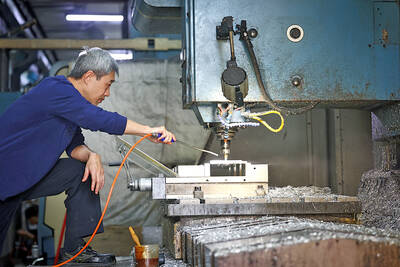The government’s plan to create a state-owned chip company by consolidating existing players may allow local computer memory chipmakers to ride out the downturn and enhance long-term competitiveness as hoped, but industry insiders remain cautious about the proposal.
Shares of the nation’s major dynamic random access memory (DRAM) chipmakers jumped by between 0.63 percent and 5.96 percent yesterday in expectation of the unconventional proposal to revitalize local DRAM companies.
“We think the government’s plan might help local DRAM players obtain advanced technologies from their foreign rivals in exchange for relief funds, leading to the enhancement of their cost competitiveness in the long run,” said Liu Szu-liang (劉思良), a memory chip industry analyst at Yuanta Securities (元大證券).
The government yesterday tapped industry expert John Hsuan (宣明智), who has worked in the semiconductor sector for more than 34 years, to help form Taiwan Memory Co (TMC, 台灣記憶體公司). A top priority will be intensive talks with potential partners Elpida Memory Inc and Micron Technology Inc on deeper technological cooperation.
“The success [of the plan] will, however, largely depend on whether the nation’s two biggest DRAM companies [Powerchip Semiconductor Corp (力晶半導體) and Nanya Technology Corp (南亞科技)] will join TMC,” Liu said.
To compete with Samsung Electronics Co, Taiwanese chipmakers will need to join forces to revamp their cost structure, control capacity expansion and share the cost of investing in next-generation technologies, Liu said.
Powerchip and Nanya yesterday took a wait-and-see attitude on whether to join the enterprise, but praised the government’s rescue efforts.
“We believe the government’s plan will provide a good opportunity for Taiwanese DRAM companies to develop their own technological capacity in the future because the investment in next-generation technology will be huge,” Powerchip spokesman Eric Tan (譚仲民) said by telephone.
But Tan said it was still too early to say whether Powerchip would join TMC because many details of the plan were still unclear.
Nanya, the nation’s No. 2 DRAM maker, also said there was not yet enough information to make a decision.
Citigroup DRAM analyst Timothy Lam (林子謙) said in a report that he expected Taiwanese DRAM makers would join TMC to resolve their debt troubles with government funds.
“While shareholders may avoid immediate bankruptcy risks, the uncertainty concerning corporate structure, continued cash outflow and potential dilution risks [as companies fund upgrades] will likely keep the sector near trough valuation,” Lam said in the report, which was released earlier yesterday ahead of the government’s announcement.
Given the recent weakness in DRAM prices, Lam remained concerned that DRAM makers would be cash-strapped and face a longer lag in technology migration versus their South Korean rivals.
“We remain cautious on Taiwan DRAM equities,” Lam said.
The spot price of DRAM dropped 1.23 percent to US$0.80 per unit yesterday evening from the previous day, market researcher DRAMeXchange Technology Inc (集邦科技) said.

SEEKING CLARITY: Washington should not adopt measures that create uncertainties for ‘existing semiconductor investments,’ TSMC said referring to its US$165 billion in the US Taiwan Semiconductor Manufacturing Co (TSMC, 台積電) told the US that any future tariffs on Taiwanese semiconductors could reduce demand for chips and derail its pledge to increase its investment in Arizona. “New import restrictions could jeopardize current US leadership in the competitive technology industry and create uncertainties for many committed semiconductor capital projects in the US, including TSMC Arizona’s significant investment plan in Phoenix,” the chipmaker wrote in a letter to the US Department of Commerce. TSMC issued the warning in response to a solicitation for comments by the department on a possible tariff on semiconductor imports by US President Donald Trump’s

The government has launched a three-pronged strategy to attract local and international talent, aiming to position Taiwan as a new global hub following Nvidia Corp’s announcement that it has chosen Taipei as the site of its Taiwan headquarters. Nvidia cofounder and CEO Jensen Huang (黃仁勳) on Monday last week announced during his keynote speech at the Computex trade show in Taipei that the Nvidia Constellation, the company’s planned Taiwan headquarters, would be located in the Beitou-Shilin Technology Park (北投士林科技園區) in Taipei. Huang’s decision to establish a base in Taiwan is “primarily due to Taiwan’s talent pool and its strength in the semiconductor

Industrial production expanded 22.31 percent annually last month to 107.51, as increases in demand for high-performance computing (HPC) and artificial intelligence (AI) applications drove demand for locally-made chips and components. The manufacturing production index climbed 23.68 percent year-on-year to 108.37, marking the 14th consecutive month of increase, the Ministry of Economic Affairs said. In the first four months of this year, industrial and manufacturing production indices expanded 14.31 percent and 15.22 percent year-on-year, ministry data showed. The growth momentum is to extend into this month, with the manufacturing production index expected to rise between 11 percent and 15.1 percent annually, Department of Statistics

An earnings report from semiconductor giant and artificial intelligence (AI) bellwether Nvidia Corp takes center stage for Wall Street this week, as stocks hit a speed bump of worries over US federal deficits driving up Treasury yields. US equities pulled back last week after a torrid rally, as investors turned their attention to tax and spending legislation poised to swell the US government’s US$36 trillion in debt. Long-dated US Treasury yields rose amid the fiscal worries, with the 30-year yield topping 5 percent and hitting its highest level since late 2023. Stocks were dealt another blow on Friday when US President Donald